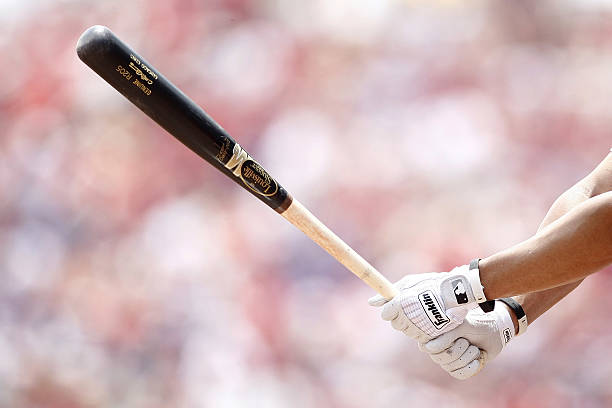In baseball, having a “hot bat” is a term used for a streak of achieving success at the plate. It also refers to a particular bat that is made with more pop than others. A hot bat refers to a baseball or softball bat that is performing exceptionally well. Consistently hitting the ball hard and far, and resulting in a higher than normal batting average for the player wielding it.
Hot bats are often designed and engineered using advanced techniques, which results in lighter, stronger bats with larger sweet spots. The players using these hot bats benefit from increased power and consistency, leading to more solid hits and potentially improved performance on the field. Just as important, understanding the science behind hot bats and exploring various techniques for making a bat “hot” can aid players in maximizing their batting potential, thus contributing to the overall success of their team.
Contents
The Hot Bat Concept
A hot bat in baseball refers to a bat that performs at a higher level than traditional bats, resulting in consistent hard and far hits that improve the player’s batting average. These bats are typically designed and engineered using advanced techniques, making them lighter and stronger with larger sweet spots.
In addition to physical characteristics, a hot bat can also refer to any bat that has been altered to provide added performance. These modifications can push the limits of bat performance, particularly in sports like men’s softball, where single-piece composite bats like the Miken ULTRA II are considered some of the hottest bats available.
While some hitters believe that a hotter bat may lead to harder-hit balls, there is a great deal of debate among players and coaches about whether this is true and which type of bat should be used for optimal results.
Factors Contributing to a Hot Bat
Physical Factors
The performance of a baseball bat is significantly influenced by a combination of elements including the bat’s material, length, and weight. High-quality materials such as aluminum or composite are known to make bats extremely responsive, improving their overall performance. Moreover, the correct size and weight distribution allow a batter to generate more power and speed during the swing, thereby increasing the chances of achieving a hot bat.
Mental Factors
A batter’s mental state can greatly affect their ability to achieve a hot bat. Confidence, focus, and discipline are vital in improving a batter’s performance. A confident and focused player is more likely to hit the ball hard and with better accuracy. Additionally, maintaining discipline in one’s approach to batting, including strike zone awareness and pitch selection, can significantly contribute to achieving a hot bat.
Environmental Factors
Environmental factors also play a considerable role in achieving a hot bat. This includes weather conditions, the type of ball used, and even the playing surface. Cold temperatures can stiffen the bat and affect the batter’s grip, while warmer weather may cause the bat to become more flexible and responsive. Similarly, the hardness and composition of the ball affect the contact between bat and ball. Lastly, considering differences in altitude and humidity can impact the ball’s flight, understanding these environmental aspects may help hitters in achieving that sought-after hot bat.
Other Meaning of Hot Bats
While a hot bat primarily refers to a bat consistently hitting the ball hard and far for a higher batting average than normal, there are other meanings associated with hot bats in basball.
Rolled Bats
Some hot bats are created by the process of bat rolling, which involves compressing a composite bat between two rollers to break in the fibers and change the bat’s rebound effect. This practice can increase the bat’s performance, making it a hot bat. However, bat rolling is considered unethical and may be illegal in some leagues.
Corked Bats
Another type of hot bat is the corked bat. A corked bat is a baseball bat that has been hollowed out and filled with cork, rubber, or other materials. Corking a bat lightens its weight and increases the trampoline effect when making contact with the ball. This process can lead to better performance by making it easier for players to hit the ball farther and more accurately.
Why Corked Bats are Illegal
Corked bats are illegal in professional baseball and many other leagues because they give the batter an unfair advantage. Altering the bat’s performance can skew statistics and compromise the integrity of the game. Moreover, using a corked bat can lead to severe penalties for players caught using them, such as fines, suspensions, and damaged reputations.
Statistical Analysis and Hot Streaks
In baseball, a hot streak or a hot bat refers to a period when a batter performs exceptionally well. This increase in performance is believed to be attributed to various factors, including improved mental focus, heightened confidence, and favorable conditions.
Common Metrics
Statistical analysis has been employed to study baseball hitting streaks and evaluate their impact on a player’s overall performance. Some common metrics used in the analysis include:
- Average – The total number of hits divided by the total number of at-bats
- On-base percentage – How often a batter reaches base, calculated by adding hits, walks, and times hit by a pitch, and dividing the sum by the total number of plate appearances
- Slugging percentage – The number of total bases achieved per at-bat, calculated by dividing the total number of bases by the total number of at-bats
These metrics can be used to analyze a player’s performance during a hot streak and compare it with their performance during normal periods. This comparison helps to identify and understand the factors contributing to improved performance.
Controversy
There is some debate about the existence of hot streaks in baseball. Some experts argue that, while players may experience fluctuations in performance, these variations are merely random occurrences unrelated to any specific “hot” or “cold” periods. A study focusing on the statistical analysis of hitting streaks in baseball found that a validated model for predicting hitting streaks contains no hot hand effect, suggesting that factors like the variability of opposing pitching might actually be more important considerations in player performance.
On the other hand, proponents of the hot streak theory counter that batters may experience genuine changes in their psychological and physiological states during hot streaks, which can contribute to improved performance. The existence of hot and cold streaks in baseball remains a topic of ongoing debate and research within the baseball community.
Famous Hot Bat Examples
A hot bat in baseball refers to a bat that has been specifically designed or altered to enhance performance during gameplay. Hot bats increase the trampoline effect when making contact with the ball, resulting in a faster and more accurate ball trajectory, as well as greater power and distance. Some of the most well-known hot bats in baseball history are associated with particular models or players. Here are some examples:
2020 Louisville Slugger Meta BBCOR: Recognized as one of the hottest BBCOR bats ever, the 2020 Louisville Slugger Meta boasts exceptional power and performance. This model has become a favorite among college and high school players, delivering great trampoline effect and ball exit velocities.
2020 Easton Ghost Fastpitch: Easton’s Ghost bat series sets the benchmark for hot bats in fastpitch softball. The 2020 Ghost model is considered the hottest fastpitch bat ever, featuring a double-barrel design and advanced materials that provide an unmatched combination of power, speed, and flexibility.
2017 DeMarini CF Zen: DeMarini’s CF Zen line has a reputation for producing hot bats, and the 2017 model stands out for its exceptional player feedback and performance relevance. Although some of these bats were later banned due to their high performance, they are still remembered for their incredible capabilities on the field.
Heinie Groh’s Bottle Bat: In the 1910s and ’20s, Heinie Groh used a unique bat with a thick barrel that extended past the label before tapering quickly to a thin handle. This distinctive design, known as a “bottle bat,” made it stand out in the era’s baseball equipment. While the concept of a hot bat was not as developed during this period, Groh’s unconventional bat can be seen as an early example of the quest for improved performance.
Impact on Teams and Game Strategy
A hot bat in baseball refers to a batter who is performing exceptionally well, hitting the ball with greater power, accuracy, and distance. This phenomenon can significantly impact both the individual player and their team’s strategy during the game.
First and foremost, having a player with a hot bat can boost a team’s confidence and morale, knowing that this batter has a higher chance of getting a hit or even hitting a home run. This can be particularly crucial in high-pressure situations when the game is on the line.
As a result, teams may adjust their lineups to maximize the hot bat’s potential. This could involve moving the player higher in the batting order so that they have more opportunities to bat, or placing them in key offensive situations where their hot bat could have a significant impact on scoring.
Moreover, hot bats can influence opposing team’s strategies. Pitchers and their coaches might adjust their pitch selection, aiming to exploit any perceived weaknesses in the batter’s swing. In doing so, they attempt to neutralize the threat posed by the hot bat and prevent extra base hits or runs driven in by the batter.
In conclusion, the presence of a hot bat in a baseball game can lead to various adjustments in both the offensive and defensive strategies employed by teams. These changes are driven by the desire to capitalize on the hot bat’s potential for increased hits and runs or to minimize its impact on the game’s outcome.


